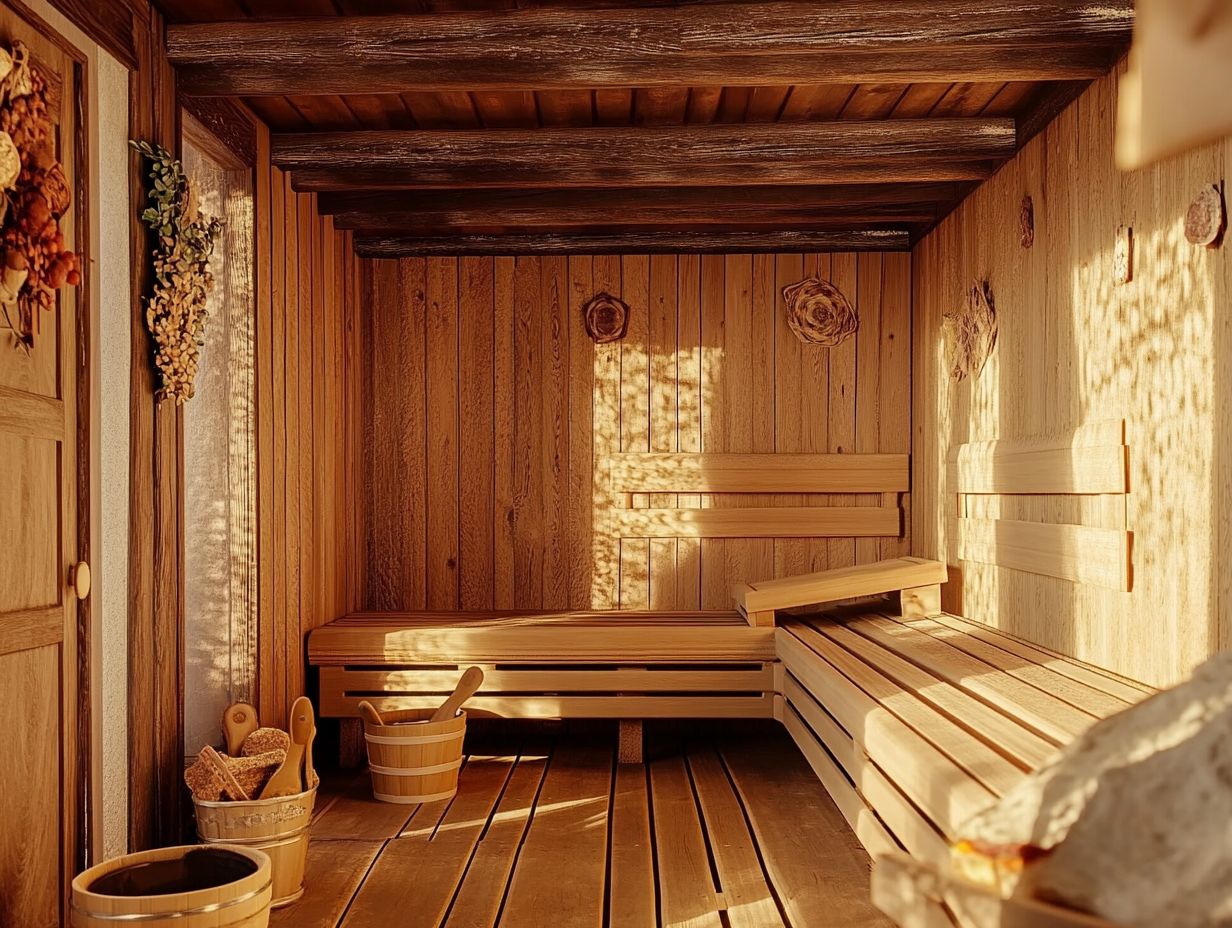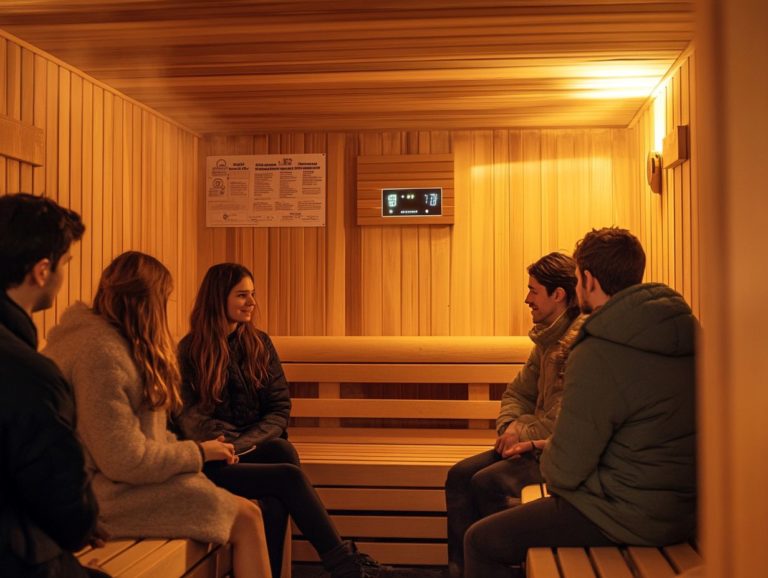Sauna Safety: Understanding Different Cultures
Saunas are revered for their calming and rejuvenating effects, yet the ways in which you engage with them vary significantly across cultures.
From the traditional rituals of a Finnish sauna to the modern adaptations you might find in wellness centers around the globe, the intricacies of sauna culture are truly captivating.
Get ready to discover the amazing benefits of sauna use! This article explores the health benefits and potential risks of saunas, provides essential safety tips, and highlights the cultural differences that influence how you enjoy these steamy retreats.
Contents
- Key Takeaways:
- What is a Sauna?
- Cultural Differences in Sauna Use
- Benefits of Sauna Use
- Potential Risks of Sauna Use
- How to Use a Sauna Safely
- Comparing Sauna Safety Across Cultures
- Frequently Asked Questions
- What safety precautions should be taken when using a sauna in a multicultural setting?
- How do different cultures view sauna use and etiquette?
- Are there any cultural taboos or restrictions to be aware of in a sauna?
- How can I ensure a safe and respectful sauna experience for everyone involved?
- What should I do if I am unsure about sauna safety in a multicultural setting?
- Is it important to respect cultural differences when it comes to sauna safety?
Key Takeaways:

- Respect cultural differences in sauna use, as practices may vary.
- Saunas offer physical and mental health benefits, but it’s essential to take precautions to ensure safety.
- Learn about cultural norms and educate yourself on safe sauna practices for an enjoyable experience!
What is a Sauna?
A sauna is not just a small room; it’s your personal sanctuary designed to elevate your relaxation experience through high temperatures and low humidity. This unique retreat is steeped in cultural traditions from around the globe.
Picture Finnish saunas with their dry heat, contrasting with steam rooms that envelop you in humidity. You can explore diverse sauna experiences, from Japanese onsens hot spring baths known for their relaxing properties to Turkish hammams, where communal bathing nurtures both social connection and wellness.
The roots of sauna culture stretch back centuries, with each type having unique practices and rituals. In Finland, for instance, the soothing sounds of nature accompany the aromatic embrace of herbs. Meanwhile, Japanese onsens focus on the therapeutic benefits of mineral-rich waters, while Turkish hammams offer meticulous cleansing rituals that foster relaxation and camaraderie.
Engaging in sauna therapy is well-regarded for its myriad health benefits, including improved circulation, the removal of toxins from your body, and stress relief. Proper etiquette like rinsing off before entering and embracing moments of quiet reflection can enrich your experience, transforming it into a rejuvenating deep cleanse for both body and mind.
Cultural Differences in Sauna Use
Sauna culture presents a fascinating tapestry of practices and customs that vary significantly across regions, each reflecting its unique cultural identity and community values.
Consider the Finnish sauna, a revered aspect of daily life, or the tranquil rituals of the Japanese onsen that invite deep relaxation. There are also the communal bathing traditions of Turkish baths, which emphasize social connections and shared experiences.
These diverse sauna experiences highlight the myriad health benefits associated with them and the rich social bonds woven through these time-honored traditions.
Traditional Uses and Practices
Traditional sauna practices encompass a rich tapestry of rituals passed down through generations, focusing on both physical cleansing and mental well-being. Each culture contributes its unique flair to the experience.
In Finland, you might encounter the vihta, a birch whisk that enhances relaxation and promotes body care. You could also integrate exfoliating gloves into your routine to invigorate your skin, embodying a holistic approach to self-care.
Meanwhile, the Japanese tradition of ‘ofuro’ invites you to soak in hot water, cultivating relaxation and mindfulness. In Native American culture, sweat lodges add a spiritual dimension to cleansing, with participants engaging in rituals that purify both body and spirit.
These varied customs reveal that sauna practices transcend mere heat baths; they intertwine with cultural values that champion wellness and rejuvenation, fostering a profound connection between you and traditional health practices.
Have you experienced any unique sauna traditions? Share your experiences and tips with others to keep the conversation going!
Benefits of Sauna Use

Many benefits come with sauna use, making it a cherished practice among wellness enthusiasts. It offers both physical cleansing and mental rejuvenation.
Regular sauna therapy can significantly enhance stress relief, promote deep relaxation, and elevate overall health. This makes sauna therapy a vital component of wellness traditions across various cultures.
Physical and Mental Health Benefits
Sauna therapy presents many physical and mental health benefits. It improves circulation, detoxification, relaxation, and stress relief. By engaging in regular sauna sessions, you may experience a reduction in anxiety and depression symptoms, illustrating its potential as a complementary approach to mental well-being.
Incorporating sauna use into your wellness routine can stimulate better blood flow, promoting heart health and aiding in recovery from physical exertion. This therapeutic heat encourages sweating, helping with the elimination of toxins and impurities, which can lead to clearer skin and improved metabolic function.
Taking time for a sauna experience allows you to unwind, providing mental clarity and a serene escape from daily stressors. By nurturing both your body and mind, sauna therapy becomes an invaluable tool for achieving holistic health and well-being.
Potential Risks of Sauna Use
While saunas offer numerous benefits, it’s important to know the potential health risks that can accompany their use. This awareness can help guarantee a safe and enjoyable experience. Risks such as dehydration, overheating, and heart-related complications may arise, emphasizing the importance of being aware and taking precautions during sauna sessions.
Precautions and Safety Measures
To maximize your sauna experience while minimizing health risks, taking the right precautions is essential. Start with the basics:
- Stay hydrated
- Monitor temperature levels
- Be aware of any personal health conditions
It’s wise to set a time limit for each session generally around 15 to 20 minutes to prevent overheating. Tune into your body; if you start feeling dizzy or uncomfortable, exit the sauna immediately. If you have any cardiovascular concerns or respiratory issues, consult with a healthcare professional beforehand to ensure your safety.
Don’t overlook the importance of hygiene: using a towel for seating can make a significant difference. Additionally, gradually increasing your temperature exposure can help your body acclimate more effectively. By being mindful of these practices, along with understanding sauna safety, you can elevate your sauna experience, making it enjoyable and safe.
How to Use a Sauna Safely

Using a sauna safely involves understanding the nuances of proper etiquette and safe practices, enhancing both your enjoyment and health benefits. Key considerations include maintaining hydration, following temperature range guidelines, and respecting the communal space.
By doing so, you ensure a positive sauna experience not just for yourself, but for everyone sharing the sanctuary. Follow these sauna safety tips for a refreshing sauna experience and embrace the full benefits today!
Tips and Guidelines for Safe Use
Regarding sauna immersion, adhering to specific tips and guidelines can significantly elevate both safety and enjoyment. This ensures a truly fulfilling sauna experience. Key recommendations include staying hydrated, taking breaks, and recognizing your personal limits to prevent overheating and dehydration.
To ensure a safe experience, remember to drink plenty of water before and after your sauna session! Hydration is essential for maintaining your body’s balance as you sweat. Consider scheduling short breaks every 10 to 15 minutes to allow your body to cool down. Always assess how you’re feeling. Everyone has different tolerance levels, so it s crucial to listen to your body and know when it s time to exit the sauna.
Practicing proper sauna etiquette like showering before entering, using a towel, and keeping noise to a minimum enhances the overall atmosphere. Understanding the importance of sauna safety training fosters respect among users and creates a calming environment that everyone can appreciate!
Comparing Sauna Safety Across Cultures
Exploring sauna safety practices across cultures unveils a captivating tapestry of approaches. These embody distinct cultural values and beliefs. Consider the Finnish sauna, where communal bathing fosters social connections. This contrasts beautifully with the tranquil rituals of Japanese onsens and the time-honored traditions of Turkish hammams.
Delving into these diverse safety practices not only enriches your understanding but also deepens your appreciation for the rich tapestry of sauna culture.
Key Differences and Similarities
The differences and similarities in sauna practices across cultures reveal much about cultural identity, safety measures, and wellness philosophies. While certain cultures prioritize communal bathing, others focus on individual wellness experiences.
For instance, in Scandinavian countries, you’ll find an emphasis on the social aspect of sauna use. Friends and family gather to relax, share stories, and rejuvenate together, reinforcing those all-important community bonds. Understanding the importance of sauna safety and community needs is crucial. In contrast, the Japanese onsens offer a more introspective experience, celebrating tranquility and solitude while adhering to strict cleanliness protocols.
These variations highlight how different cultures interpret bathing as not merely a physical cleanse but also a profound spiritual revitalization. Safety measures, like keeping the right temperature and hydrotherapy techniques, further illustrate the health benefits perceived in various traditions. This showcases a beautiful intertwining of cultural practices and holistic wellness philosophies.
Frequently Asked Questions

What safety precautions should be taken when using a sauna in a multicultural setting?
Sauna safety is important in any setting. It’s especially crucial to understand and respect different cultures when using a sauna. Some safety precautions to keep in mind include being mindful of cultural dress norms, communicating clearly with others in the sauna, and being aware of any cultural taboos or restrictions regarding sauna use.
How do different cultures view sauna use and etiquette?
Different cultures have varying attitudes and beliefs surrounding sauna use. This can affect how they approach safety measures and etiquette. For example, some cultures may have specific rituals or traditions associated with sauna use. Others may have strict rules about hygiene or socializing in the sauna.
Are there any cultural taboos or restrictions to be aware of in a sauna?
Yes! It’s important to be mindful of any cultural taboos or restrictions when using a sauna in a multicultural setting. For example, in some cultures, it may be considered disrespectful to enter the sauna while wearing any clothing. In others, it may be seen as unacceptable to touch or use certain sauna accessories.
How can I ensure a safe and respectful sauna experience for everyone involved?
To ensure a safe and respectful sauna experience for all, it’s important to be aware of and respectful of different cultural norms and beliefs. This may include communicating clearly and respectfully with others in the sauna, following any cultural dress norms or restrictions, and being mindful of any cultural taboos!
Key Takeaways:
Understand cultural norms. Stay hydrated! Take breaks! Respect others to create a positive sauna experience.
What should I do if I am unsure about sauna safety in a multicultural setting?
If you’re unsure about sauna safety in a multicultural setting, be careful. Research the cultural norms around sauna use and ask someone knowledgeable for guidance.
Is it important to respect cultural differences when it comes to sauna safety?
Yes, respecting cultural differences in sauna safety is essential. This ensures a safe, comfortable experience and fosters cultural understanding.
When we honor diverse beliefs, we create a welcoming sauna environment for everyone.






